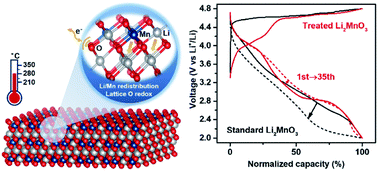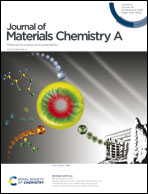Suppression of voltage-decay in Li2MnO3 cathode via reconstruction of layered-spinel coexisting phases†
Abstract
Voltage decay, i.e., the voltage decrease during electrochemical cycling, has been a decade-long challenge for lithium-ion batteries. This issue not only leads to a substantial loss of energy density, but also raises challenges for the battery management system, hindering the commercial application of high capacity lithium-rich oxide. Here, we show that through a combination of electrochemical conditioning and thermal treatment, Li2MnO3, the parent compound of lithium-rich oxide, which typically displays severe voltage and capacity decay, could be converted into a new phase that essentially suppresses the voltage decay with improved capacity retention and rate performance. By combining atomic-sensitive nuclear magnetic resonance, differential electrochemical mass spectrometry and synchrotron-based resonant inelastic X-ray scattering, we disclose that treatment triggers the formation of three-coexisting phases, i.e., the lithium-rich layered, spinel and defect spinel phases, which enables improved reversibility of the oxygen redox activity and enhanced manganese redox reactions in the initial cycle. Our findings suggest the key role of the local structure in the voltage decay problem and provide insights for material optimizations towards lithium- and manganese-rich cathodes without the voltage decay.



 Please wait while we load your content...
Please wait while we load your content...